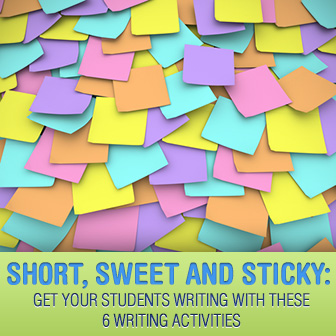7 Easy Icebreakers You Can Do With Post-It Notes


When you are using them in the classroom, it’s not how much you write but what you write. You can use these simple sticky notes to get your students started on all kinds of writing projects. Keeping the planning simple makes the writing assignments less intimidating, and this can be extremely important for students of English as a second language. To get your students started with words on the page, try these simple note making activities.

Part of being a good teacher is having good relationships with your students, but that is not always easy to do when you teach a big class. You can use this simple note writing technique with your students to create one on one dialogue and get them to practice their writing skills at the same time. A few minutes before the school day is over, give each person a post-it note to stick on his or her desk. On the note, encourage your student to tell you something about their experiences that day. You might ask what activity they found particularly interesting or what they may not have understood during the day. If you like, have a ready list of questions posted in your classroom so your students can refer to it each day when they write their notes. Then, once the class has left, go through the class and read these notes. Make notes back to your students (on additional post-its) so they know you have heard what they said. You will feel closer to your students, and you may find out some interesting facts that your students may have been too shy to share during class!
Every story has four essential pieces – the character, setting, conflict and resolution. To make sure your ESL students are including all of these essentials in their next story, do this activity before you write. Give each student four post-it notes (four different colors if possible) and explain the four elements that each story should contain. Keeping it simple is best. Character is who is in the story. Setting is where the story happens. Conflict is the main problem in the story, and the resolution is how that problem gets fixed. Then, have your students write the character, setting, conflict and resolution for the story they will be writing on their four post-its. Now when they go to write their stories, they will have a physical reminder of everything they need to include to make sure their stories are complete.
I often use a six panel comic strip to teach my students about narrative arc when they are writing stories, and the activity easy translates to using post-its in the classroom. Give each student six post-it notes and have her arrange them in a line on her desk. On the first post-it, have your students draw a picture of the main character. On the second, she should draw the setting. On the third note, she draws the problem that the main character encounters. Then, on notes four and five, she draws the problem getting worse and worse. On the last note, the student draws her main character solving her own problem. Once each student has these six pictures, she can use these as a guideline as she writes her story. When she does, her story will come out with a strong narrative arc. Drawing the pictures also helps students who might otherwise be intimidated in a foreign language writing class.
Using small post-it notes, have each person in your class design a stamp that they would like to see printed. The stamp should feature a person, and your students will have to explain why they think that person should have their own official postage. After the stamps are designed, have each person write a letter to the U.S. Post Office explaining why this person should be featured on a stamp. Your students should give three or four good reasons in their letter as well as a short biography of the person. Your students should then include the picture they drew on the post-it and close their letters appropriately. If you like, extend the activity by creating the stamps your students proposed. Several websites let you print your own U.S. postal stamps from an image you upload from your computer.
How do opinions vary among your students? Is there a majority and a minority when it comes to popular issues? To see what your students are really thinking, have a post-it poll in your classroom! Write a question that touches on a popular issue on your board, and give each student a post-it on which to write his answer. Once everyone’s answers are written, have them stick their post-its to the board to form a bar graph which shows the possible answers to the question. Once students can see where their classmates’ opinions fall, have each person write an essay about the issue. In the essay, he should identify whether his opinion came in line with the majority or the minority, why he chose that side of the issue, and what he would say to sway someone from the opposition.
You can use post-its in your classroom to create a conversation with a paper trail. Give each student several post-it notes. On the first, have him answer a question. Any question will work, but you might want to tie the question into a unit you are studying in class or have students share information that will help them get to know one another better. Make sure everyone has written his name on the note, and then have your class stick their notes on an open bulletin board. Give your class a chance to read what their classmates have written, and then have them respond to one of the notes on their second post-its. Again, students should write their names on the notes and then stick them below the note they responded to. Repeat this activity with a third and fourth post-it. Now that the conversations are finished, review with your students the differences between quoted and reported speech. Each student should then choose one of the conversations and write it using correct grammar and punctuation in both quoted and reported styles.
In your next writing class, try one of these post-it activities and see just how much of what you are teaching sticks with your students!